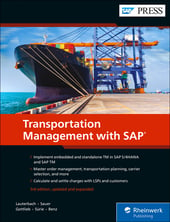Despite the proliferation of air-based shipping in recent decades, the most cost-effective way for companies to dispatch product overseas is by sea.
With a little bit of thought, this shouldn’t be surprising. After all, shipping liners can measure up to 1,300 feet in length and carry over 10,000 metal containers (or “sea cans,” in shipping parlance). It may take more time to get product to its location, but the economies of scale that a ship provides means cheaper overall shipping costs for producers. For companies operating at or near their margin, this can be a big benefit.
Those running shipping logistics with SAP Transportation Management (SAP TM) are familiar with the benefits of the solution, such as procurement management, cargo management, and track and trace. When it comes time to send product overseas, however, it’s likely that these companies will rent a shipping container and space on an ocean freight liner rather than perform the journey themselves. For those companies, a specific add-on makes the most sense.
SAP TM Add-on for Container Shipping Liners
The SAP Transportation Management add-ons for container shipping liners for SAP S/4HANA logistics help integrate and automate container shipping processes for companies that are renting space out on a liner.
Currently available for the on-premise version of SAP S/4HANA, the add-ons include pricing management, export and import documentation assistance, and data consistency. These are all crucial to ensure that their ocean freight can get where it needs to go in a timely manner.
The SAP ocean freight webpage highlights a number of helpful functionalities that would assist container shipping liner firms, such as automatic formatting of quotations, surcharge calculations for different shipping durations, booking coordination for companies that don’t have their own fleets of ships, and ranking of proposed routes to see which ones make the most sense.
If and when a hiccup occurs during the shipping route (such as a storm or closed port), documentation is updated for all stakeholders so they know what happened and when to expect the shipment to arrive.
SAP Transportation Resource Planning
For companies providing ocean freight services, the SAP Transportation Resource Planning solution is an important tool. Created for companies with large fleets of delivery inventory, including vans, airplanes, and boats, it allows for pre-planned movement of these assets so they’ll be available when needed. This is perfect for companies with high seasonal demand—for example, holiday tree farms won’t need vehicles during the majority of the year, but come November they’ll need to begin rotating transportation into the area so they can deliver their trees to all those popup stores in parking lots which provide freshly cut trees.
In another timely example, the recent COVID-19 pandemic brought about a surge of online shopping at retailers like Amazon. Delivery couriers such as USPS, UPS, FedEx, and even Amazon’s own Prime delivery fleet were quickly inundated with deliveries, and many needed to add to their fleets in order to meet demand within a reasonable timeframe. A tool like SAP Transportation Resource Planning would allow these companies to determine which areas of the country were underserved and needed additional resources the most.
Our book Transportation Management with SAP: Embedded and Standalone TM lists this shortage/surplus inventory as one of the major features of SAP Transportation Resource Planning. Three other important features include:
- Request and answer functionality for specific asset availability, such as shipping containers
- Ingoing and outgoing asset stream registration for a complete look at what is actually available and what’s currently being used
- Repositioning simulation to determine the best and most cost-effective way to make sure assets are where they need to be to meet demand
In terms of container shipping, the functionality of SAP Transportation Resource Planning can be used to track boat locations and see what types of liners are available and where they should be dispatched. If companies expect their supply chains to be interrupted due to events like the pandemic or a turbulent hurricane season, they can reposition assets ahead of time to stock up on inventory or weather storms.
SAP Yard Logistics
For those involved in running actual ports, the SAP Yard Logistics solution will be helpful. With this product, yard managers can gain insight into their processes in order to use space most efficiently, such as tracking how long offloading takes, determining whether container storage is being done optimally, and reducing idle time where nothing is happening. It can also help schedulers plan transport alongside carriers, and utilizes automation to streamline different scheduling processes.
While the solution provides benefits for all aspects of a yard (such as internal transport of goods), the application for shipping liners makes it an attractive option. Learn more about how SAP Yard Logistics serves as the “missing piece” between TM, extended warehouse management, and SAP ERP here.
Conclusion
Shipping product via water has long been a tried and true practice for logistics companies. Given its popularity and the potential for delays due to weather and other unforeseen circumstances, it’s important for companies involved in ocean freight to plan things ahead of time and have flexibility when things don’t go as expected. With the SAP TM add-ons for container shipping liners, SAP Transportation Resource Planning, and SAP Yard Logistics, those involved in every step of container shipping with SAP have options to complete their tasks with success.
Want to learn more about transportation management with SAP? Check out our list of books for both SAP ERP and SAP S/4HANA systems here.



Comments